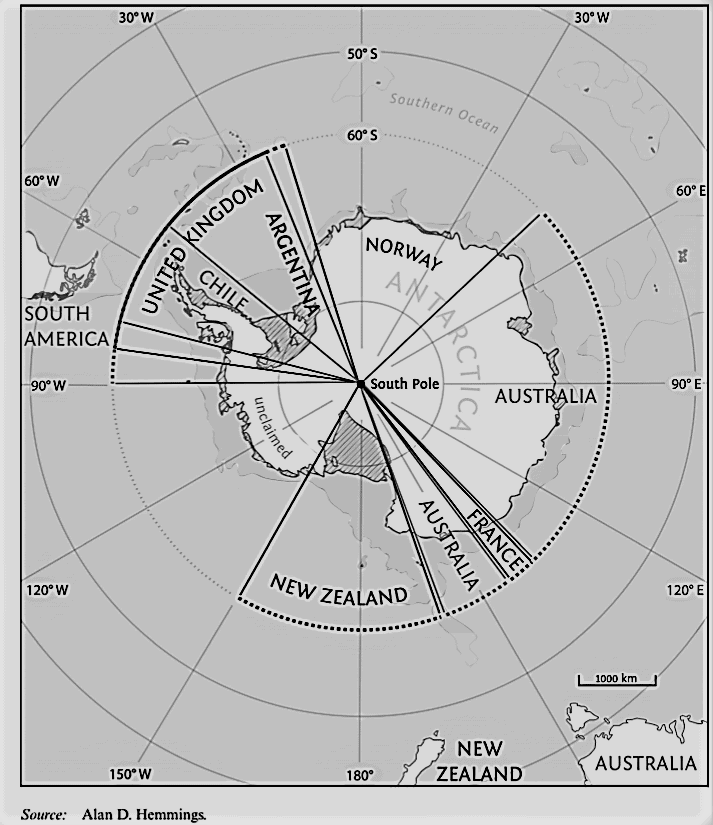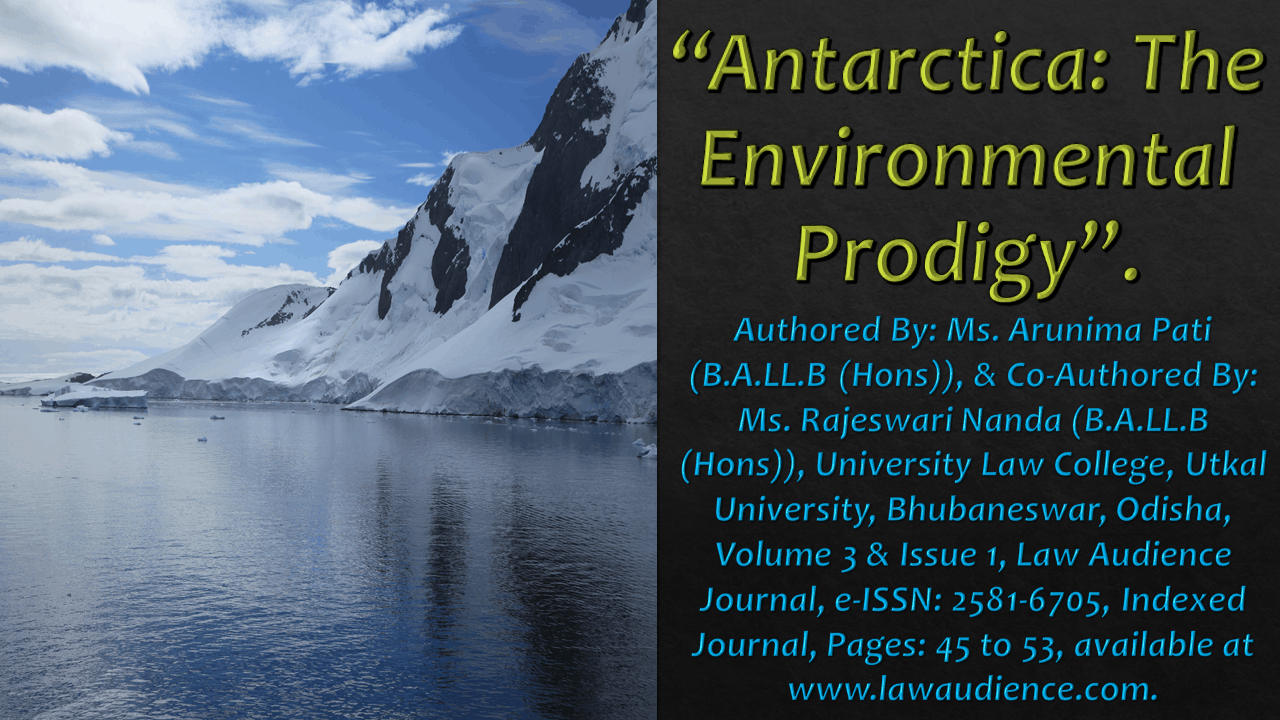Click here to download the full paper (PDF)
Authored By: Ms. Arunima Pati (B.A.LL.B (Hons)), & Co-Authored By: Ms. Rajeswari Nanda (B.A.LL.B (Hons)), University Law College, Utkal University, Bhubaneswar, Odisha,
Click here for Copyright Policy.
ABSTRACT:
“Antarctica, as magical as the word sounds is a miracle in itself saving and conserving nature’s best secrets and future under its permafrost and reservoirs. Modern Day research projects, regarding the continent, are carried out within the very ice-laden places, apparently to study and reveal those secrets and that has accentuated too many degrees of degradation regarding the habitat there. It is not a secret that we have an Ozone Hole over the big land, due to various factors. The increasing number of permanent research stations, though are necessary but in long term are depleting the supposedly unmanned pristine place on Earth to an extent un-imaginable, causing damage to the habitat of the flora and fauna there. This article thus tries to find out both the political and environmental factors concerning a threat to the Continent and tries to suggest required solutions”.
Keywords: Antarctica, Antarctic Treaty System, Biodiversity, Sovereignty, Sustainability.
I. BACKGROUND:
It was in 1840 that Antarctica was termed as a continent and not merely a group of islands or an area on ocean, and since then a number of changes are acclaimed to the evolving science and human population that the initial un-inhabited land serves, as home to many year-round and seasonal research stations. The inception of explorations could be credited to the early 20th Century, but even then, the area did not have much of human activity which rose significantly following the World War II[1].
Seven Countries, namely UK, Chile, Argentina, Norway, Australia, France, New Zealand have made territorial claims which most countries do not recognise. An Antarctic Treaty was negotiated and signed in 1959 to build the legal regime to govern the permafrost lands which neither gives nor denies the existing territorial claims, and to this day an unresolved territorial sovereignty shadows a major part of Antarctica. What needs to be done is getting a proper legal regime to govern the sovereignty while balancing the research and resources with habitat protection and conservation otherwise as predicted through new research ‘Antarctica will be having a climate tipping point by 2060 with catastrophic melting if carbon emissions aren’t cut quickly’[2]
I.I ANTARCTICA AS NATURAL RESERVE:
Antarctica, like space belongs to no-one and everyone at the same time. The ice sheets of Antarctica are the greatest fresh water reserves storing about 80% of Earths freshwater with about 400 sub-glacial lakes. Lake Vostok, being the largest of those and is deeper than the deepest Lake Baikal, and thus a home to a huge number of species. Being a global resource both in spirits and in practice makes its conservation as important as rest of the parts of Earth and more so because it is the last and largest place on Earth having a chance to be spoiled by human influence, and is a home to marine world nowhere else to be found.
II. REGULATIONS BINDING SCIENCE AND POLITICS:
The generally uninhabitable continent; Antarctica, is the bed rock of curious minds attempting to find new revelations. Due to its unidentified sovereignty issues and several claims, it is still regulated by a variety of international treaties, compromising state rules and political norms around Antarctic Treaty System (ATS)[3]. These are mainly classified into three categories: Metropolitan Law of Individual States; Globally Applicable International Law, such as the U.N. Convention on the Law of the Sea (UNCLOS); and International Law Adopted Under the Regionally Focused ATS. All states can apply their metropolitan law to their nationals. States that assert sovereignty over territory also seek to apply their metropolitan law to all other nationals in these areas. Now this is a matter of fact that, the continent is claimed by various countries, to regulate their sovereignty over specific areas. Complicating the issue, the international treaties mainly focus on the easy functioning of scientific and biodiversity research without any threat of power struggle. Though the longevity of this attempt is highly fleeting and yet to be seen.
II.I THE ANTARCTIC TREATY SYSTEM:
Formed in 1959, earlier comprised by 12 states, this system tries to end the positions on territorial sovereignty, which also allowed Consultative Parties to adopt the Agreed Measures for the Conservation of Antarctic Fauna and Flora, as well as generating an essential duty to avoid harmful interference with their natural habitat. The treaty also created categories of Specially Protected Species and Specially Protected Areas by the year 1964. Generally focused on geopolitical ends, the Antarctic Treaty also made significant contributions to the development of Environmental Law.
Some important regulations are-
- Article IV: Established science as the basis for Antarctic presence and cooperation with free access to terrain and scientific data.
- Article I and V: Demilitarized the continent by ways of forfeiting establishments of military bases and fortifications, military manoeuvres, and weapons testing. It also established a reassuring inspection regime including the prohibitions of nuclear explosions and waste disposal.
- Article IX: The consultative states to sit periodically, concerning, inter alia, measures regarding “preservation and conservation of living resources in Antarctica.”
These core regulations gave rise to many sub sequential legislations for the time bearing challenges of the hour. For example- 1972 Convention for the Conservation of Antarctic Seals, 1980 Convention for the Conservation of Antarctic Marine Living Resources (CCAMLR), 1988 Convention on the Regulation of Antarctic Mineral Resource Activities, 1991 (Replaced by Madrid Protocol), Protocol on Environmental Protection to the Antarctic Treaty (Madrid Protocol). These protocols aim to expand the horizon of the treaty into the marine habitat and maintain the scientific and non-scientific experiments on ocean animals, perceived risks through mineral extractions in the continent, curbing it to the extent of researches. Thus, making the area, “a natural reserve, devoted to peace and science”. Some precautionary focus is evident in the environmental principles, which include injunctions to avoid significant adverse environmental effects and guidelines to plan and conduct activities “on the basis of information sufficient to allow prior assessments of, and informed judgments about, their possible impacts on the environment.”[4]
II.II GLOBAL ENVIRONMENTAL INSTRUMENTS:
Apart from the treaty and the consulting states, the whole world is engaged in one or more way of environmental agreements on the continent. For example-
- Convention for the Conservation of Southern Bluefin Tuna (CCSBT): It manages a single species, Thunnus maccoyii, wherever that occurs. Generally inhabiting a belt across the South Pacific and South Indian oceans immediately north of the CCAMLR[5] Upon Japan’s unauthorized cultivation of the species around the year 2000, the execution of this protocol remains constricted.
- The Agreement on the Conservation of Albatrosses and Petrels (ACAP): It acts as a precautionary measure for the habitat of the species present in both the Antarctic Treaty Area as well as on sub-Antarctic islands. This global agreement closely works with” Convention on the Conservation of Migratory Species of Wild Animals” and the ATS.
- Convention on Biological Diversity (CBD): It focuses on particular challenges for the Antarctic regional dispensation. Contradicting with ATS, it also stands on commercial realization of biodiversity through “bio-prospecting”[6], especially in the Polar Regions, creating a tug of war between the interests of the territorial bodies.
- United Nations Convention on the Law of the Sea (UNCLOS): This convention also in contradiction to ATS, provides jurisdictional claims to the coastal states surrounding the continent. Under Article 76 of UNCLOS, a coastal state may submit data concerning any extension beyond 200 nautical miles for consideration by a Commission on the Limits of the Continental Shelf (CLCS) and if becomes successful, can have exclusive rights on that area. This convention clearly undermines Article IV of Antarctic Treaty which doesn’t have any specific criteria to recognize such claims. This limbo of various jurisdictions indeed creates a turf of claims and powers, contradicting the centralization of legality throughout the continent.
II.III REGULATIONS BY NEARBY NATIONS:
Although the discovery of Antarctica started around 1950, by which most of the surrounding countries had already claimed their sovereign jurisdiction upon the coastal areas and surrounding islands. For example,
- The sub-Antarctic islands, all lying north of the Antarctic Treaty Area, are subject to national jurisdictions of nearby nations such as Argentina, Chile and United Kingdom. Argentina disputes two groups—South Georgia and the South Sandwich Islands, which are also claimed by the United Kingdom—as part of the wider Falklands/Malvinas imbroglio. These areas are thus governed by their respective metropolitan laws, although sometimes with discretionary clauses in relation to non-nationals; this avoids difficulties with states that do not recognize their jurisdiction or disagreements with obligations under the Antarctic Treaty.
- Another part of existing coastal islands like Australia’s Heard and McDonald Islands are managed by an International Union for Conservation of Nature (IUCN). This body establishes the regulations regarding the biodiversity as well as marine reserves through an Environment Protection and Biodiversity Conservation Act (1999).
- World Heritage Convention 1972, is another body which includes the surrounding islands into world’s cultural and natural heritage. The nominations for such sites are accepted annually and thus protected under this body.
III. IDENTIFYING THE ISSUES:
The ATS responsible for the regulation of the Continent what-so-ever has DNA of intellectual and political purposes to its brim.
The issues that the Continent deals with can be categorized into two major heads:
- Sovereignty and Political issues;
- Environmental issues;
III.I SOVEREIGNTY AND POLITICAL ISSUES:
- Apart from the seven claimant countries that put territorial claims (since their colonial era annexations) among which three substantially overlap, another sector remains between 90˚ and 150˚ west longitude that is unclaimed, thus leading to chaotic law regime.
- The ‘Antarctica’ towards south of the Polar Front that forms the area beyond National Jurisdiction (ABNJ) has no recognized laws of its own and is regulated through a combination of individual state laws, international treaty law, soft law and political norms around the ATS, and thus leading to no definite measures to check or term what is “illegal”[7].
- The Continent of peace and science is home to a number of living and non-living components of Earth, and though the mineral exploitation is banned by the Environmental Protocol to the Antarctic Treaty except for the scientific research purposes the limit to which is not effectively set.

III.II ENVIRONMENTAL ISSUES:
- If our climate continues to warm and acidify the Southern Ocean causing parts of the Continent to experience ice retreat while increase on others, scientists predict that krill populations could be devastated, undermining the entire food chain.[8]
- Illegal, unregulated and unreported fishing threatens fish stocks as the global fisheries deplete, thereby putting the sea birds and marine mammals depending upon them in risks, while the harmful fishing methods used by the vessels cause direct deaths of a large number of sea birds.
- Persistent Organic Pollutants and Micro plastics threaten the habitats of the Continent.
IV. WHAT NEEDS TO BE ACHIEVED?
IV.I FOR SOVEREIGNTY AND POLITICAL ISSUES:
- ATS and the Environmental Protocol to be amended to suitably fit both claimant and non-claimant countries and to be made applicable for the whole of Antarctica keeping aside conflicting Domestic Laws to avoid chaos.
- A separate Regulatory Body (Permanent) to watch and inspect the application of International Instruments (ATS and the protocol) constituting of surrounding Countries and Major UN States.
- Sanctioning Regulations that would penalize and deter the mineral and biodiversity exploitation should be made and matters related to the same should be solved by any fast and effective means of dispute resolution without dragging litigation for years.
IV.II FOR ENVIRONMENTAL ISSUES:
- The Green house gas and carbon Emission Regulations for countries throughout the world are to be made stringent and strict through domestic laws.
- The Regulatory Body to keep a check on all such happenings of illegal and unreported fishing, mining, bio-prospecting, etc and put sanctions whenever and wherever required.
- Neighboring countries to pre-decide and limit the amount of POPs and Micro plastics flowing towards the continent through a warranted undertaking to be inspected and checked by the Regulatory Body.
- Governmental and Non-Governmental Organizations like World Wide Fund for Nature to be promoted to make efforts towards conservation and sustainability of bio-diversity of the Continent.
V. CONCLUSION:
Antarctica is the coldest, windiest, highest (on average) and driest continent and during summer receives more solar radiation being in South Pole than is received at the Equator in an equivalent period.[9] This along with other current environmental issues stirs the Earth every now and then.
The breaking off of ‘World’s Largest Iceberg’ as glaciers retreat measuring around 170 kms long and 25 kms wide, making it larger than New York’s Long Island and half the size of Puerto Rico[10] is the latest example.
84 scientists coming from 15 different countries concluded that the more ambitious national goals to cut greenhouse gas emissions and slow down climate change set recently are not enough to stop sea levels from rising.[11]
The implementation of above-suggested solutions could prevent the horror that is coming.
Footnotes:
[1] CIA World Factbook.
[2] By Julie Brigham- Grette (Professor of Geosciences, University of Massachusetts Amherst) and Andrea Dutton (Professor of Geoscience, University of Wisconsin- Madison), Antarctica is headed for a climate tipping point by 2060, with Catastrophic melting if carbon emissions aren’t cut quickly, accessible at: https://theconversation.com/antarctica-is-headed-for-a-tipping-point-by-2060-with-catastrophic-melting-if-carbon-emissions-aren’t-cut-quickly-160978, accessed on 19th May 2021.
[3] The Antarctic Treaty System is defined in Article 1 of the Madrid Protocol as ‘the Antarctic Treaty, the measures in effect under that Treaty, its associated separate international instruments in force and the measures in effect under those instruments’.
[4] Alan D Hemmings, Environmental Law – Antarctica, January 2011.
[5] Convention for the Conservation of Antarctic Marine Living Resources.
[6] Investigation of living things to see how they can be commercially useful to humans.
[7] Alan D. Hemmings, Klaus Dodds and Peder Roberts, Introduction: the politics of Antarctica, January 2017.
[8] WWF- Antarctica.
[9] CIA World Factbook.
[10] World(c) 2021, Bloomberg Laura Millan Lombrana, BloombergUpdated: May 19, 2021 7:49 pm IS.
[11] Supra.
Cite this article as:
Ms. Arunima Pati & Ms. Rajeswari Nanda, Antarctica: The Environmental Prodigy, Vol.3 & Issue 1, Law Audience Journal, Pages 45 to 53 (26th May 2021), available at https://www.lawaudience.com/antarctica-the-environmental-prodigy/.



